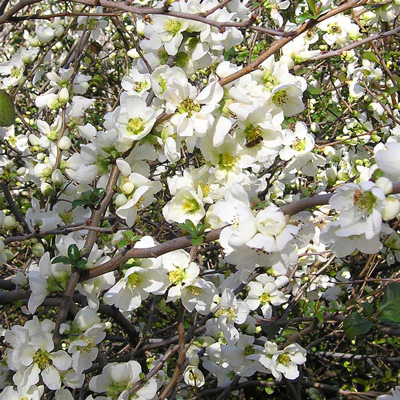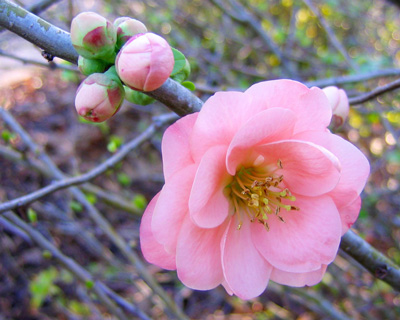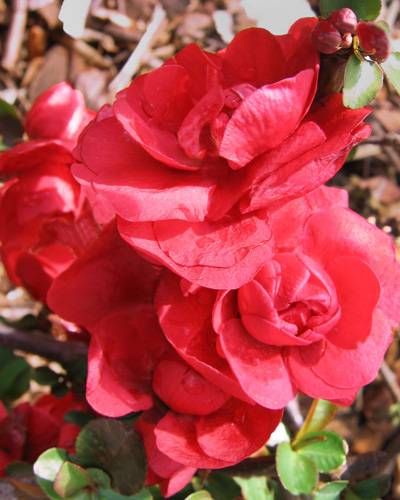Best Predictor of Spring by Steve Huddleston

Nothing signals that spring is just around the corner like flowering quince. This is an old-fashioned shrub that has been in Texas gardens for decades. It’s a shrub your grandmother probably grew and loved, and now you and I are climbing back on that bandwagon, too.
Use flowering quince as an informal hedge, in a mass planting, as a border, or even as an espalier against a wall. Because of its thorny nature, quince makes a great barrier plant.

There are several cultivars of flowering quince. ‘Texas Scarlet’ produces orange-red flowers, ‘Jet Trails’ yields white flowers, and ‘Cameo’ bears peach-pink flowers.
The new ‘Double Take’ series of quince reaches a compact size of 3-4 feet tall and produces larger, 2-inch flowers with more petals. The flowers resemble camellia blossoms, and the branches sport no thorns (most other quince varieties do). The three colors in this series are ‘Scarlet Storm,’ ‘Pink Storm,’ and ‘Orange Storm.’
What you need to know…
• Common name: Flowering quince. Still referred to by many Native Texans as “japonica,” referring to its old scientific name of Chaenomeles japonica. That’s risky, however, because other plants truly from Japan also get saddled with the same name.
• Scientific name: Chaenomeles speciosa. It’s in the Rosaceae, or Rose Family and is native to China.
• Winter durability: USDA Hardiness Zones 4a-8b, which means it’s perfectly suited to all parts of our state.
• Plant size at maturity: 4-8 ft. tall and 4-6 ft. wide. Shorter types are also sold.

• Growth habit: Rounded, dense shrubs with thorns produced abundantly throughout the branches.
• Exposure preference: 6 or more hours of sunlight, but tolerant of less. Blooms more heavily in brighter light.
• Soil preference: Tolerant of many but thrives in sandy loam that has continuous supply of moisture. Will show iron chlorosis in alkaline soil.
• Flowers are 1-2 in. in diameter, red, pink, white and orange, single or double. They are borne abundantly before the plant puts out its new leaves in late winter.

• Attracts hummingbirds in warmer climates (since it blooms in late winter) and butterflies and, therefore, fits well into a butterfly or pollinator garden.
• May bear fruit, so could be considered to be an edible crop. Fruit-producing types of quince are also available, but not so much for landscaping use. Quince jelly is similar to apple jelly and equally delicious.
• Best place to use flowering quince: Toward the back of a perennial border or shrub bed or where it can “disappear” during the summer. It’s an ugly duckling during the growing season.
Important Tip: If you’re interested in adding a flowering quince to your landscape this year, better get with it soon. They sell almost instantly when they come into bloom at area nurseries.
